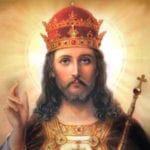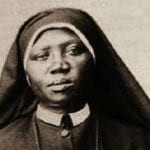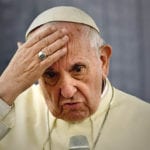 Weird Stuff
Weird Stuff  Weird Stuff
Weird Stuff  Mysteries
Mysteries 10 Tragic Disappearances and Deaths in Joshua Tree National Park
 History
History 10 Ways Childhood Really Sucked in the Old West
 Music
Music 10 Name Origins of Famous Bands from the 1990s
 Religion
Religion 10 Biggest Turnarounds by the Catholic Church
 Weird Stuff
Weird Stuff 10 Unbelievable Times Laws Had Unintended Consequences
 Humans
Humans Ten Historic Women Who Deserve Way More Credit Than They Got
 Movies and TV
Movies and TV 10 Films That Spawned Major Lawsuits
 History
History Ten Times Towns Were Wiped Off the Face of the Earth
 Creepy
Creepy 10 of the Most Disturbingly Haunted Public Houses in the UK
 Weird Stuff
Weird Stuff 10 Niche Subcultures That Are More Popular Than You Might Think
 Mysteries
Mysteries 10 Tragic Disappearances and Deaths in Joshua Tree National Park
 History
History 10 Ways Childhood Really Sucked in the Old West
Who's Behind Listverse?

Jamie Frater
Head Editor
Jamie founded Listverse due to an insatiable desire to share fascinating, obscure, and bizarre facts. He has been a guest speaker on numerous national radio and television stations and is a five time published author.
More About Us Music
Music 10 Name Origins of Famous Bands from the 1990s
 Religion
Religion 10 Biggest Turnarounds by the Catholic Church
 Weird Stuff
Weird Stuff 10 Unbelievable Times Laws Had Unintended Consequences
 Humans
Humans Ten Historic Women Who Deserve Way More Credit Than They Got
 Movies and TV
Movies and TV 10 Films That Spawned Major Lawsuits
 History
History Ten Times Towns Were Wiped Off the Face of the Earth
 Creepy
Creepy 10 of the Most Disturbingly Haunted Public Houses in the UK
10 Of The Most Important Councils That Defined The Catholic Religion
Christianity, as it has been passed down to the present, is based squarely on the Bible—but perhaps not solely, especially as far as Roman Catholicism is concerned. It’s not so controversial to think of the following ecumenical councils as adding or taking away from the religion proper, since they are not the only examples of a post facto interpretation of the Bible. After all, Saint Paul never met Christ, and yet Christianity as we know it is based primarily on Paul’s interpretations of the Gospels. Over the years, Catholic ecumenical councils have met to decide many other key details of the Christian belief system.
10Second Council Of The Vatican
1962–65
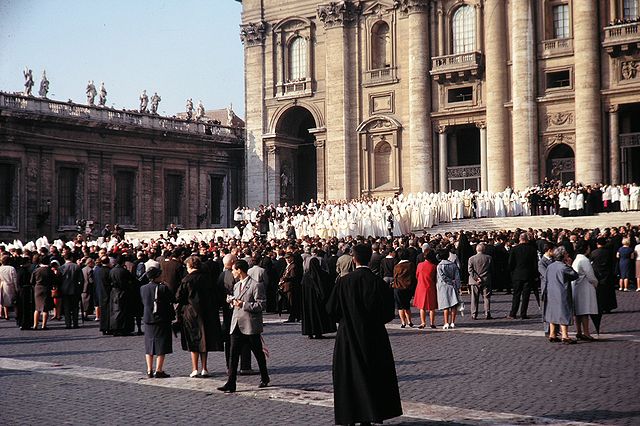
John XXIII convened the most recent council to examine the Catholic Church’s role in the modern world. With global communication increasing and the Cold War in full swing, the Church assembled a mighty team of theologians, four of whom would later become popes: Giovanni Montini (who succeeded John XXIII as Paul VI during the council), Albino Luciani (John Paul I), Karol Wojtyla (John Paul II), and Joseph Ratzinger (Benedict XVI).
Uniquely, Vatican II did not produce any official dogmatic definitions, with Church leaders emphasizing the council’s pastoral nature and promising that prior doctrine would remain intact. This led many to question the council’s purpose, with one Cardinal warning that “to convoke a General Council, except when absolutely demanded by necessity, is to tempt God.”
But the council did produce some important changes. It admonished the Church’s global congregation to focus more firmly on the Bible as the sole source of God’s instruction to humanity, while still respecting the literature of history’s popes, saints, and Doctors of the Church such as St. Thomas Aquinas. Adopting a theme of reconciliation, the council encouraged respect for Judaism and Islam, encouraged dialog with other Christian groups, and paved the way for languages other than Latin to be used during Mass.
However, perhaps its most important declaration came in Lumen Gentium, “Light of the Peoples,” which stated that salvation was possible for non-Catholics and non-Christians, so long as they sincerely sought God. While confirming that Christianity should be deemed the one catholic (meaning “universal,” when not capitalized) and apostolic faith given to Peter by Jesus and properly governed by Peter’s successor, the Pope, Lumen Gentium acknowledged that “many elements of sanctification and of truth are found outside its visible confines.”
9Second Council Of Constantinople
553
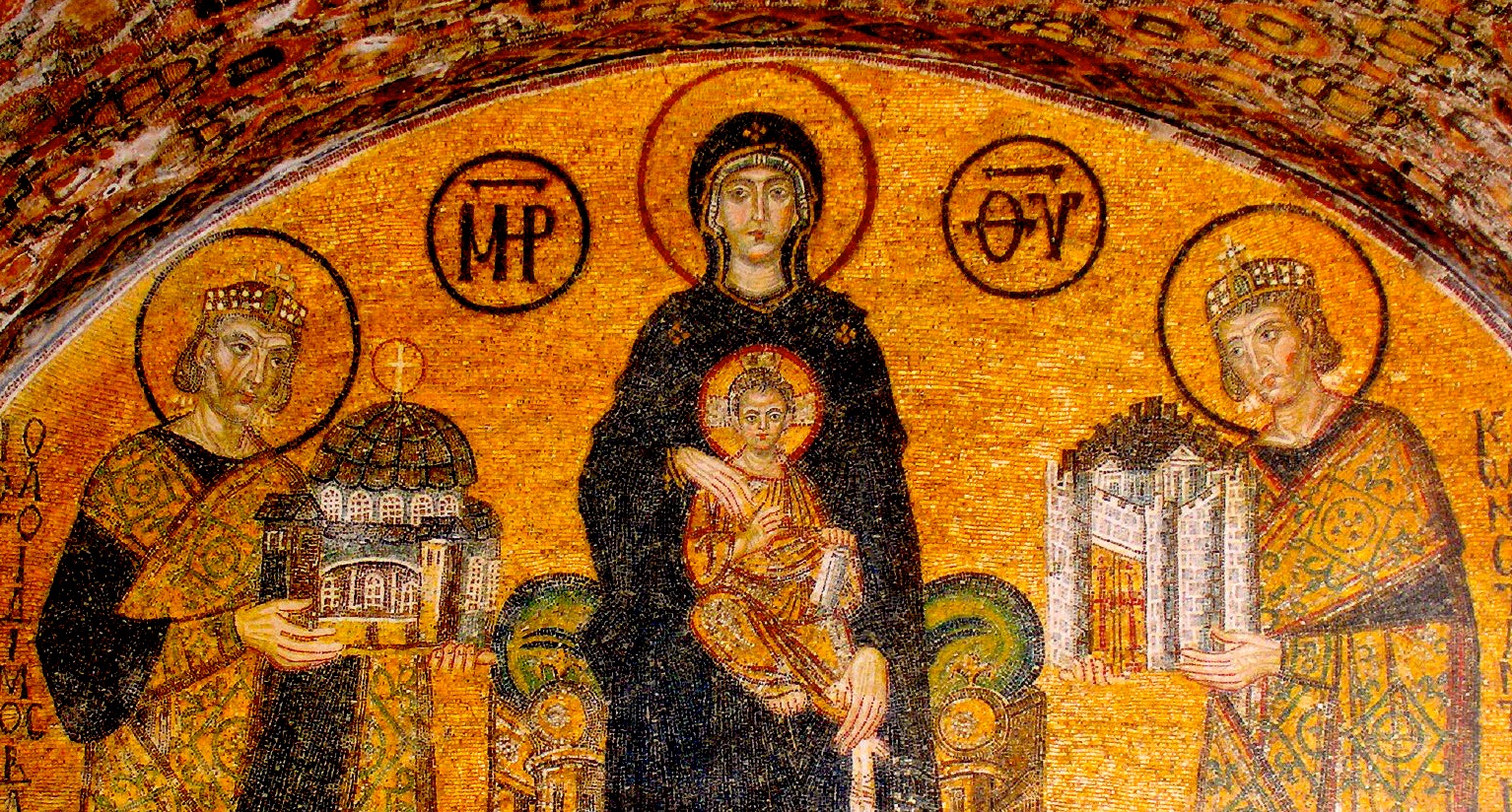
This council was convoked by Byzantine Emperor Justinian I and almost all of the attending bishops were from the Byzantine Empire, with only six Western bishops attending. Justinian summoned the council to settle the controversy surrounding the writings of Theodoret of Cyrrhus, Ibas of Edessa, and Theodore of Mopsuestia (all dead by the time the council met), whose collected work, the so-called “Three Chapters,” had caused a schism in the Church by appearing to support Origenism and Nestorianism.
Origen Adamantius was a prolific theological author of the third century, who wrote that, at the end of all things, every creature that has ever existed, plant, animal, and human, good and evil, even Satan, will be reconciled back to God, and all that will remain is perfect love. There will be no Hell, no punishment, no sorrow. He also held that Jesus Christ is subordinate to God the Father. The council condemned these views as heretical.
Nestorius was an Archbishop of Constantinople who taught that Jesus the man and Jesus the Son of God were so different that they were actually two separate people spiritually joined together. He based this statement on the notion that Jesus cannot be God Himself, since Jesus died on a cross and God cannot die. The council also condemned this, and in an attempt to unify all the schismatics, declared that Christ and Jesus were one and the same and that Christ Jesus had a single function and will—to die for the sins of humanity.
8First Council Of The Vatican
1870
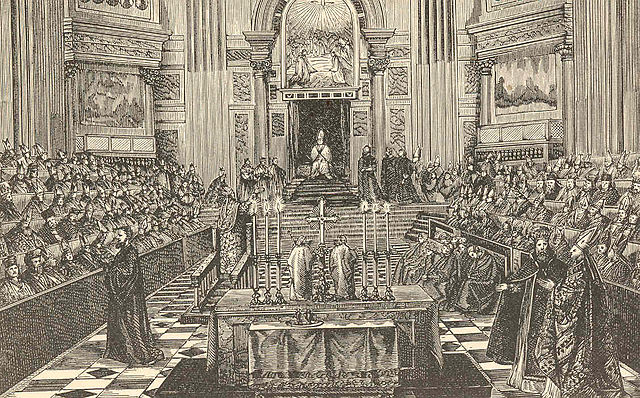
The first council in over three centuries was convoked by Pope Pius IX after about five years of preparation in order to settle several matters deemed serious threats to Christianity. Since the Council of Trent, the Renaissance had given way to the Age of Enlightenment, during which atheism and liberalism became increasingly popular.
The council redefined multiple points of the Christian faith, standing firm on the value of faith in the face of a tide of liberal “free-thinking” and materialism. To this end, the council defined rationalism to be insufficient for happiness in life. Materialism was equally denounced, and the human described as having a soul, even if they did not believe in God. The Bible was officially designated as having been written by mortal men under the divine inspiration of God.
The council also defined the doctrine of Papal infallibility. This has been much misunderstood, and does not apply to everything the Pope says or does. Rather, the Pope is only considered infallible when he is speaking ex cathedra—in other words, when he is “exercising the office of pastor and teacher of all Christians” in order to define a doctrine to be held by the whole Church. This is generally agreed to have only occurred twice since 1870—in 1950, when Pius XII taught that the Virgin Mary had ascended bodily into heaven, and in 1994, when John Paul II declared that women should not be ordained as priests.
7Third Council Of The Lateran
1179
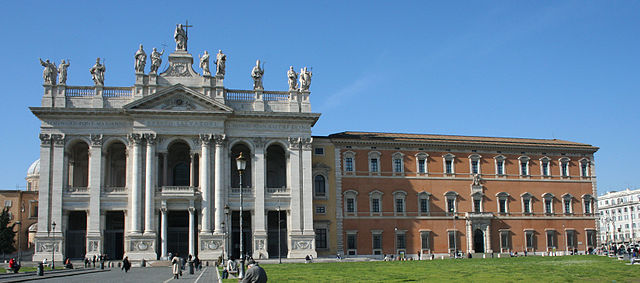
This council saw Pope Alexander III presiding over around 300 bishops in three sessions at the Papal Archbasilica of Saint John Lateran in Rome. Over the previous three decades there had been a severe schism between the Papacy and the Holy Roman Emperor Frederick Barbarossa, who wanted to extend his influence into Italy. Although Alexander III had the support of most of the Church, the Emperor backed a rival candidate, who subsequently declared himself Pope Victor IV—one of history’s many antipopes. The two sides reached a truce in Venice two years before the council.
First on the council’s agenda was to forestall any subsequent schisms that might arise. To this end, it was solemnly declared that no one could be considered pope unless at least two-thirds of the College of Cardinals had voted for him. Anyone attempting to assume the Chair of Saint Peter without a two-thirds majority would be automatically excommunicated.
Catharism—which holds that there are two Gods, one good and one evil—was denounced and outlawed, but the council decided not to take strong action against Waldensism, a precursor to Protestantism proper (it is possible that the council, mindful of the recent schism, did not want to split the Church further by excommunicating the Waldensians). The council also forbade priests to charge a fee for conducting marriages or burying the dead.
6Second Council Of Nicaea
787
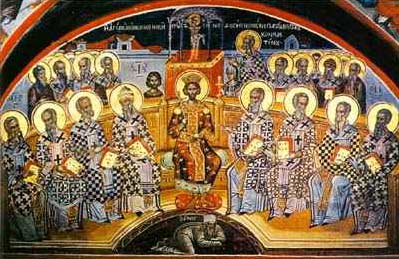
The Empress Irene, acting as a regent for her son Emperor Constantine VI, convoked this council in an attempt to settle the issue of Byzantine iconoclasm—a rift in the Eastern Church caused by the fear that religious images and icons, including the image of Jesus on the cross, constituted graven images and were hence forbidden by the Bible. For years, paintings, tapestries, and other religious artifacts had been attacked throughout the Byzantine Empire and their use had been explicitly banned by Irene’s husband, Constantine V.
The issue seems remote today, but aroused huge passions at the time—the council was violently interrupted by iconoclast soldiers and had to be postponed until loyal troops arrived to protect it. Eventually, the council rejected iconoclasm, affirming that venerating icons was not blasphemous, since the simple crucifix was a universal reminder of Christ’s death, accepted even by the iconoclasts. If a plain cross was acceptable, the council ruled, then other images were as well, since they could strengthen the faith of some worshipers. The council expressly forbade the actual worship of images but affirmed that they should be revered.
5Fourth Council Of The Lateran
1215
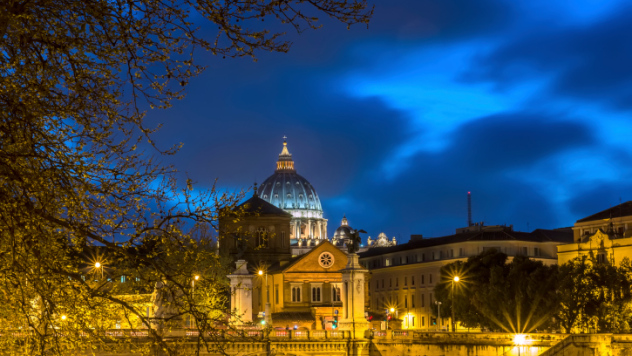
Pope Innocent III gave a full two years to prepare for this council, which enabled an extremely large body to attend. Along with the Pope, there were the Patriarchs of Jerusalem and Constantinople, 71 archbishops, 412 bishops, and 800 abbots and priors, including representatives of the Knights Hospitaller and Templar. Notably, the council forbade members of the clergy from pronouncing death sentences against anyone, regardless of the offense against the Church. Offenders could be excommunicated, but only the secular political power of the area could put them to death. Oddly, the same canon prohibited priests from acting as surgeons.
The council insisted that Jews and Muslims living within its sphere of influence should wear special dress distinguishing them from Christians and called for the Eastern Orthodox Church to reunite with Rome. It also declared the Church’s approval of the ongoing Fifth Crusade, and promised indulgences for all crusaders, and even those who sponsored a crusader financially.
More lastingly, the council officially decreed that every Christian was required to confess their sins to the parish priest at least once a year. Confession had been a common, though not requisite, practice for centuries, but it was now made official. And perhaps most importantly, the council made the Church’s first official reference to transubstantiation—the belief that, upon the priest’s prayer and thanks over the Eucharist, God changes the bread and wine into the body and blood of Christ, with the bread and wine remaining bread and wine in outward physical appearance only.
4Council Of Chalcedon
451
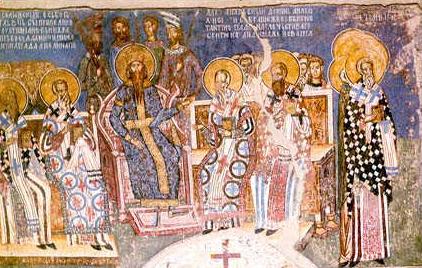
Chalcedon (now known as Kalikoy) was a city southeast of Constantinople where the Byzantine Emperor Marcian convoked a council to resolve a number of minor spiritual disputes and to define the physical and spiritual nature of Jesus Christ. Their conclusion is now called the Chalcedonian Definition, and it states that Jesus was both a completely mortal human being and completely God incarnate, with “the difference of the natures having been in no wise taken away by reason of their union, but rather the properties of each being preserved and both concurring into one Person.”
This was in direct opposition to Patriarch Dioscorus of Alexandria, in attendance, who refused to accept that Christ was “a union of two natures,” but said that he was prepared to accept the idea of Christ as “a union from two natures.” This single word was sufficient to get him deposed from his position and exiled to the island of Gangra, off the northern coast of Turkey. However, he retained the support of the Egyptians, and the incident played a key role in the split between the Egyptian Coptic Christians and the rest of the Church, which endures to this day.
3Council Of Basel, Ferrara, And Florence
1431–45

The bitterest, most convoluted council the Church has ever held was convoked by Pope Martin V in Basel, moved to Ferrara and later Florence by his successor, and would last for 14 years in one form or another. At the heart of the agenda was the schism between the Eastern and Western churches, although the council also debated how the Hussite Wars might be ended diplomatically. The time seemed ripe for reconciliation, since the Byzantine Empire was desperate for support against the Turks.
But there was still the problem of the theological differences between Roman Catholicism and Eastern Orthodoxy, most notably the problem of Purgatory. Neither side could reconcile the principle of original sin with unbaptized children who died in infancy, having never done anything sinful. These babies certainly could not be in Hell, but since they had the sin of Adam on their heads at birth, they could not be in Heaven, since no sin can enter into the presence of God. Both sides cited 2 Maccabees 12:41–46, 1 Corinthians 3:11–15, Hebrews 12:29, and 2 Timothy 1:18 as proof of the possibility of Purgatory, and on this topic the schism was nearly resolved, but a single Eastern bishop, Mark of Ephesus, refused to sign the council’s agreement, rejecting the Western insistence that purgatory was filled with fire. Mark also strongly objected to the inclusion of the phrase “and the Son” in the Nicene Creed, which he felt undervalued the role of God the Father.
The intransigent bishop was placed under house arrest, and the council tried to resolve the schism without his approval, but the majority of the Orthodox faithful sided with Mark. The matter was left unfinished and the council, which had been plagued by schisms of its own, reached no major agreements. Constantinople fell to the Ottomans a short time later.
2Council Of Trent
1545–63

This council lasted so long that it was convoked on three separate occasions by three separate popes (Paul III, Julius III, and Pius IV). The main issue facing the council was the development of Protestantism, especially Lutheranism—Martin Luther himself was alive for the first year of the council, although he did not attend it.
As part of its response to this new threat, the council resolved to reform the Church’s administration, which had become deplorably corrupt. The attendees agreed with Martin Luther that practices such as the selling of indulgences were anti-Biblical and had to be stopped. The council did not, however, adopt a conciliatory approach to Luther or his followers.
Protestantism was officially labeled heretical in every difference between its interpretation of the faith and the Catholic Church’s. The council also confirmed the importance of the Deuterocanonical books (Judith, Tobit, 1 and 2 Maccabees, Wisdom, Baruch, and Ecclesiasticus), which had been repudiated by many Protestant sects.
The council defined the Sacraments as seven in number: Baptism, Marriage, Confirmation, Penance, Anointing of the Sick, Holy Ordination, and the Eucharist (bread and wine), and reaffirmed the doctrine of Purgatory.
1First Council Of Nicaea
325

The first official ecumenical council of the Catholic Church was convoked by Constantine I, in Nicaea (now Iznik, Turkey), for the purpose of unifying Christianity. This was a challenging task, since Western Christians and Eastern Christians did not see eye to eye on a number of points. In addition, there were a number of different sects who interpreted the Scriptures in a variety of imaginative ways, most notably the Gnostics.
The three most important issues faced by the council were how to date Easter, the question of Arianism, and the schism of Melitius. The dating of Easter had not been universally organized prior to this council, with most sects observing it according to various interpretations of the Jewish calendar. The council decided to date it as a moveable feast day, to be celebrated on the first Sunday after the full moon following the spring equinox. This system gives a variance of almost a full month.
Arius was an elder and theologian in the Alexandrian church who stated that Jesus, being the Son of God, is subordinate to God the Father. This may seem of little importance, but Arius took the concept further, stating that Jesus did not always exist as God has, but was instead created in Heaven by God from nothing at all as a pure divine being. In Arius’s opinion, Jesus and God were not the same entity. The Council voted in favor of denouncing this concept as heretical, and officially defined God, Jesus, and the Holy Spirit as of the same substance. They based this on various passages in the Bible, primarily in John: “I and the Father are one.”
Melitius was a bishop of Lycopolis in Egypt who preached an unforgiving stance against apostates (someone who abandons their religion). Those apostates Melitius refused to welcome back into the Christian fold were mostly victims of persecution, who recanted their faith under torture and later sought to rejoin the Church. The council condemned Melitius and his followers for preaching a decidedly un-biblical concept, and officially stated that anyone who lapses from the faith but later recants of this and professes himself to be Christian must be forgiven.
FlameHorse is a writer for Listverse. He also frequents Imgur, but he’ll never tell his user name.
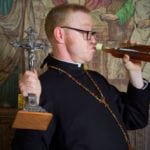
![Top 10 Most Important Nude Scenes In Movie History [Videos] Top 10 Most Important Nude Scenes In Movie History [Videos]](https://listverse.com/wp-content/uploads/2019/09/sharonstone-150x150.jpg)

